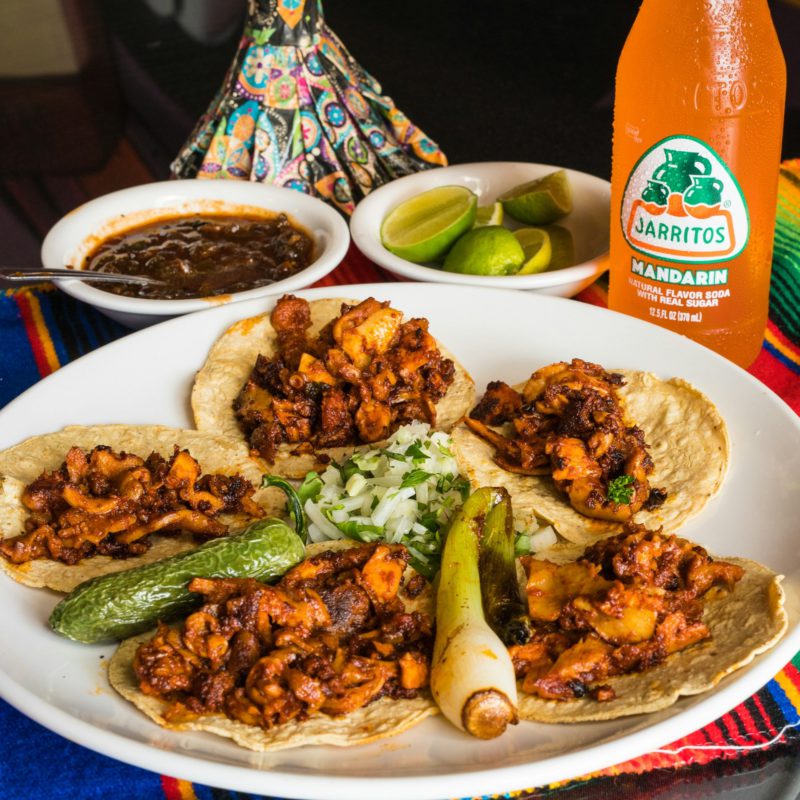Mexican cuisine, with its roots deeply embedded in ancient Mayan and Aztec traditions, has been celebrated for centuries for its vibrant flavors, diverse ingredients, and colorful dishes. From the fresh corn and beans that have been staples for thousands of years to the bold, complex tastes of chilies and chocolate, Mexican food has blossomed into a beloved culinary art that’s cherished around the globe.
In this guide, we will explore the delicious array of Mexican dishes enjoyed throughout the day. Discover the traditional dishes that Mexicans typically savor for breakfast, lunch, and dinner, and indulge in the sweet treats that make Mexican desserts so irresistible. Read on to uncover the culinary treasures of Mexico! Don’t forget to bookmark this guide before you travel — and if you’re ready to explore the best of Mexican food with your friends, start planning an epic Mexico trip with TourHero to live your BEST foodie life! 🌮 😉
Breakfast
Mexicans embrace breakfast as a vibrant and essential part of their daily routine, infusing their mornings with energy and warmth. Breakfast time is often a communal experience, where families gather to enjoy a leisurely start to the day. The meal is an opportunity to savor simple pleasures, whether it’s sharing stories, enjoying a cup of coffee, or indulging in comforting dishes.
Chilaquiles
Chilaquiles are a beloved Mexican breakfast dish with roots in Aztec cuisine, known for their simplicity and versatility. The dish starts with day-old tortillas, cut into triangles and lightly fried until crispy. These tortillas are then simmered in green or red salsa, creating a perfect blend of soft and crunchy textures. Chilaquiles can be garnished with a variety of toppings such as shredded chicken, queso fresco, crema, onions, and avocado.
🇲🇽 Variations of chilaquiles: Variations you may find include chilaquiles verdes (green salsa) and chilaquiles rojos (red salsa). Sometimes, the dish is served with eggs or beans on the side. Traditionally, chilaquiles are enjoyed as a hearty breakfast or brunch and are a staple in many Mexican households!
🍽️ The proper way to eat chilaquiles: To truly savor chilaquiles, dig in while the tortillas are still slightly crispy. Mix the toppings, allowing the crema and salsa to blend perfectly with the tortillas. Pair it with a fresh glass of orange juice or a hot cup of Mexican coffee for the ultimate Mexican food breakfast experience.
Tamales
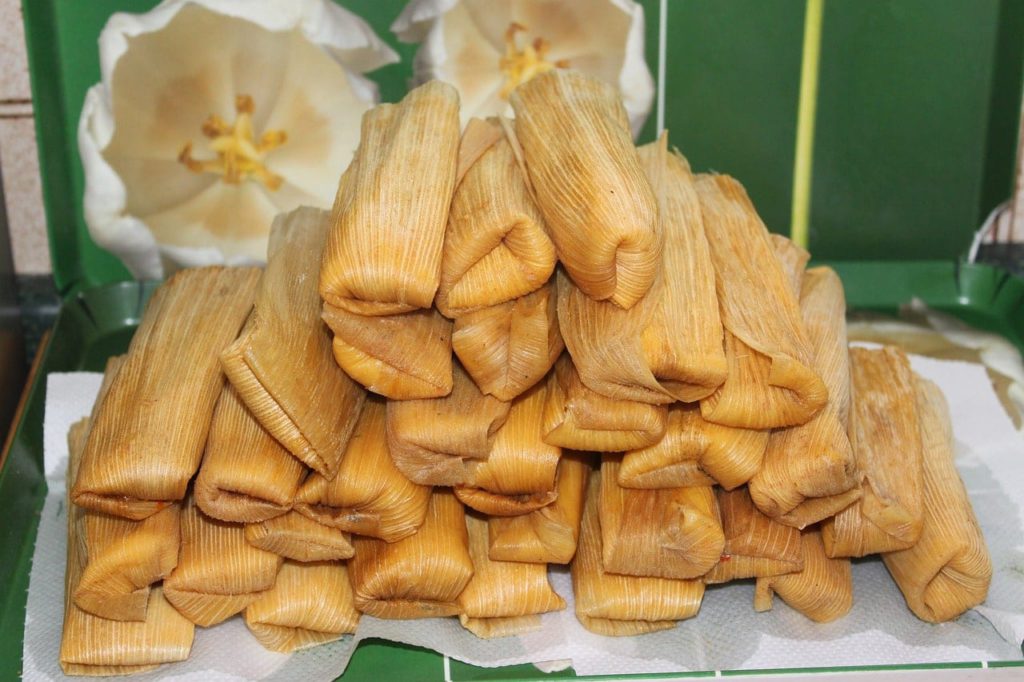
Tamales are a traditional Mesoamerican dish that dates back thousands of years, with origins in the indigenous cultures of Mexico. Made from masa (corn dough) that is spread on a corn husk, tamales are filled with a variety of ingredients, including meats, cheeses, chilies, or even sweet fillings like fruits. The husks are then folded and steamed until the tamales are tender. Tamales are deeply ingrained in Mexican culture, often prepared during festive occasions and family gatherings.
🇲🇽 Variations of tamales: There are countless regional variations, such as tamales oaxaqueños, which are wrapped in banana leaves and filled with mole, and tamales dulces, which are sweetened with sugar and flavored with ingredients like cinnamon or raisins. Making tamales is often a communal activity, with families gathering to prepare large batches that are shared with friends and neighbors, embodying the spirit of togetherness in Mexican culture.
🍽️ The proper way to eat tamales: To enjoy tamales, carefully unwrap the corn husk and savor the masa and filling together. Take small bites, ensuring you taste the rich combination of flavors in each mouthful. Pair tamales with a warm cup of atole for an authentic Mexican breakfast.
Atole
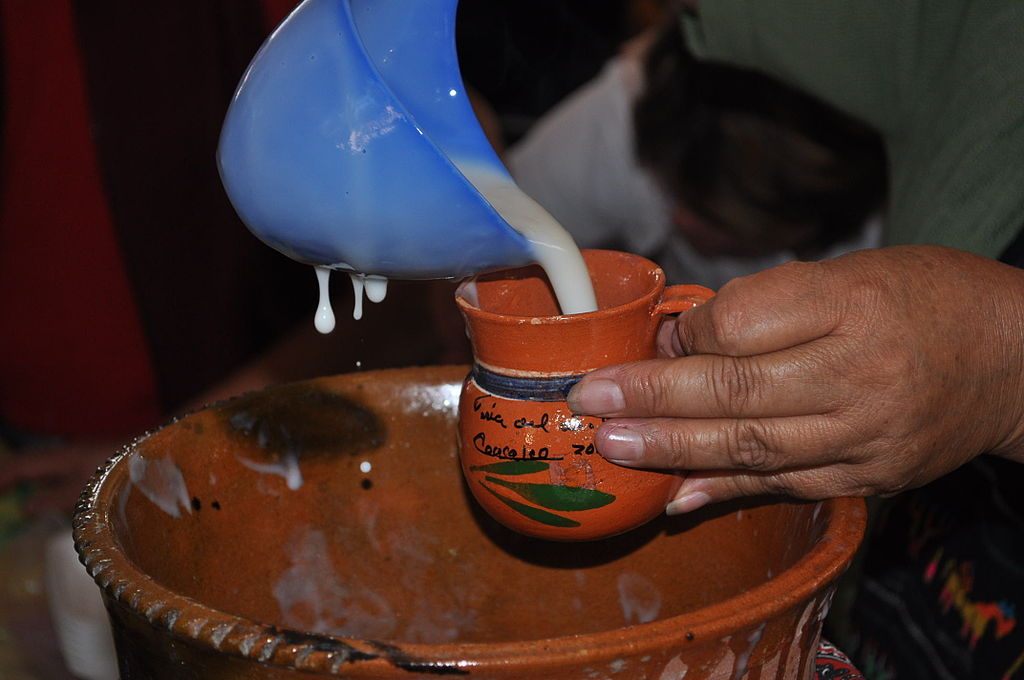
Atole is a traditional Mexican beverage with roots tracing back to the Aztec civilization, where it was made from corn, a staple of the Mesoamerican diet. The base of atole is masa harina (corn flour), mixed with water, milk, and sweeteners like piloncillo (unrefined cane sugar). The drink is then flavored with vanilla, cinnamon, or chocolate, known as champurrado when chocolate is added. Atole’s consistency can range from thin and drinkable to thick and porridge-like. It is especially popular during holidays like Día de los Muertos and Las Posadas.
🇲🇽 Variations of atole: Variations of atole include atole de fresa (strawberry atole), atole de guayaba (guava atole), and atole blanco (plain atole without sweeteners), showcasing the versatility of this comforting and historic drink.
🍽️ The proper way to drink atole: Sip atole slowly to appreciate its comforting warmth. If it’s thicker, enjoy it with a spoon like a porridge. Pair it with tamales for a perfect balance of flavors and textures in your morning meal.
Lunch
Lunch in Mexico is often considered the most important meal of the day. It’s a time when families and friends come together to share not just food, but conversation and a sense of community. Lunch is typically enjoyed at a leisurely pace, allowing everyone to fully savor the rich flavors and hearty dishes.
Tacos al pastor
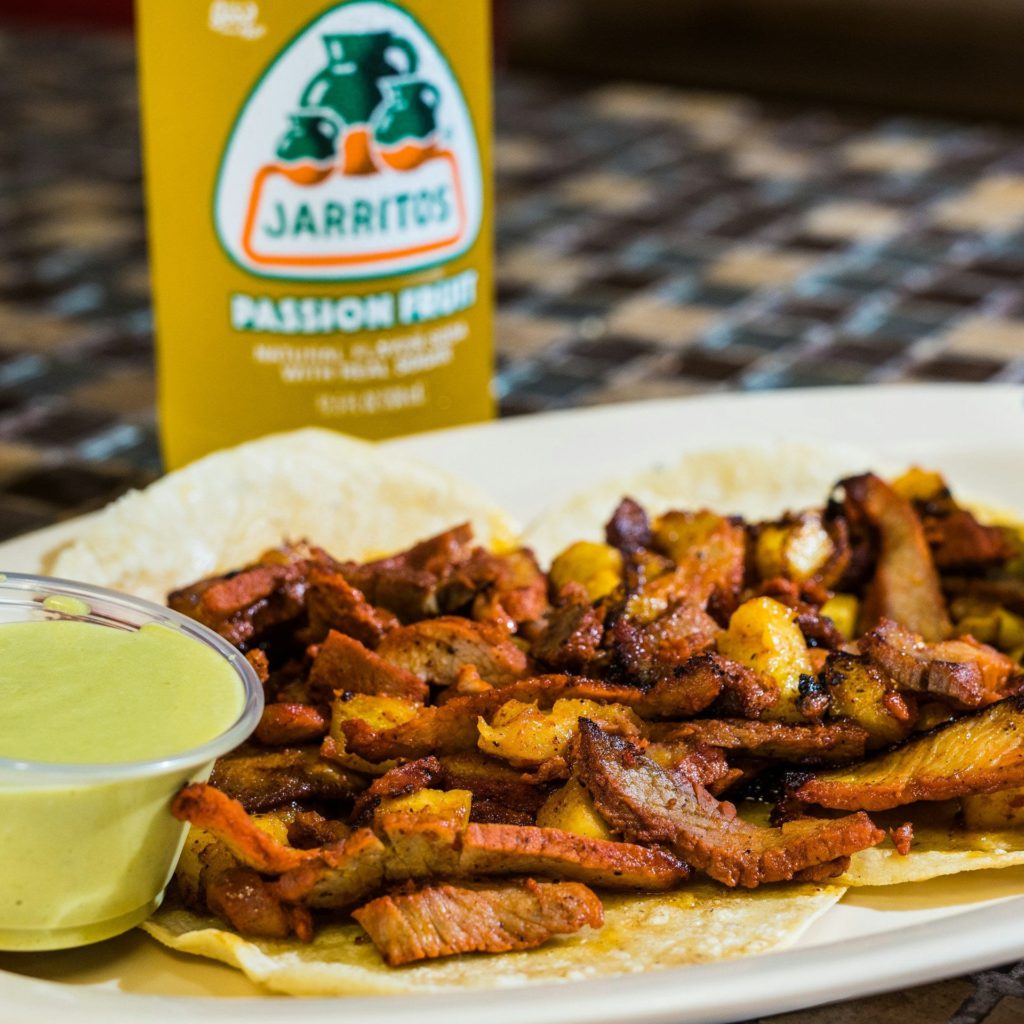
Tacos al pastor are a quintessential Mexican street food with origins in the 1920s, brought to Mexico by Lebanese immigrants who introduced shawarma. The dish features thin slices of marinated pork cooked on a vertical spit, similar to shawarma. This cooking style gives it a unique smoky flavor. The marinade typically includes achiote, pineapple juice, vinegar, and a blend of spices, resulting in a savory and slightly sweet taste. The meat is thinly sliced and served on small corn tortillas, topped with diced onions, cilantro, and pineapple, with a squeeze of lime for a tangy finish. Variations of tacos al pastor can be found across Mexico, but the dish remains especially popular in Mexico City, where it’s often enjoyed as a late-night snack.
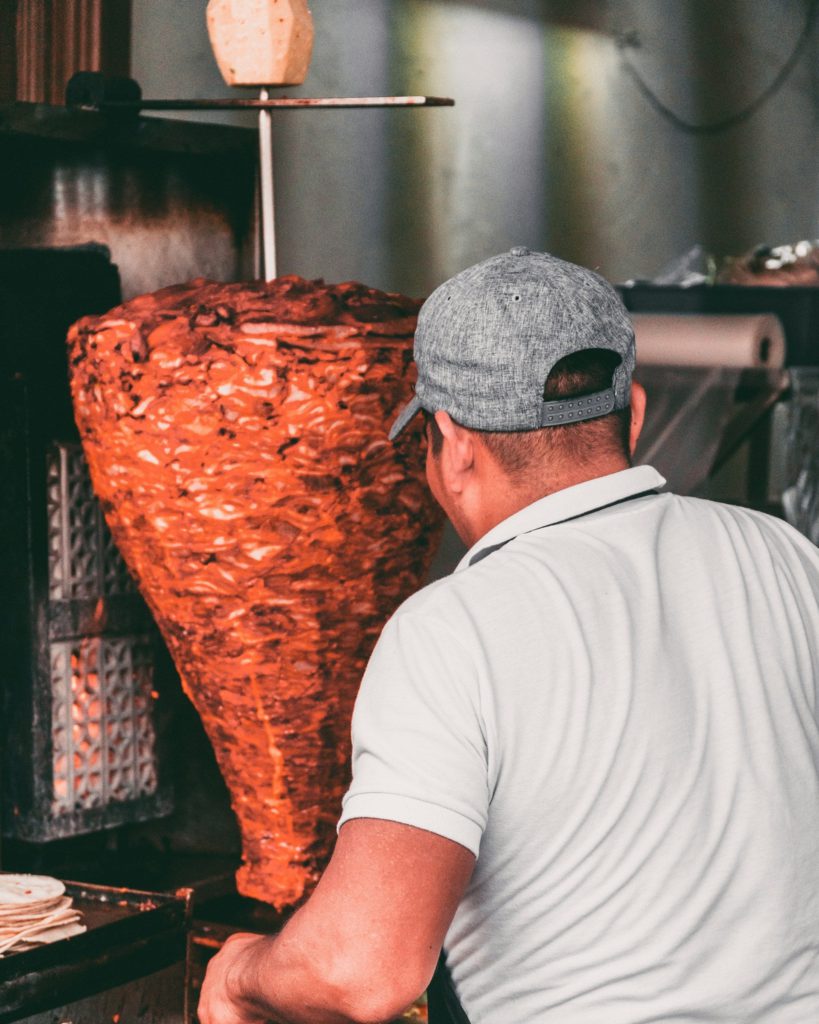
🇲🇽 Variations of tacos al pastor: You may encounter tacos arabes, where the meat is served in pita-like bread instead of tortillas. Other variations include pirata, combining the meat with refried beans and cheese, and alambre, where the meat is mixed with bell peppers, onions, and cheese, often served with tortillas to assemble yourself.
🍽️ The proper way to eat tacos al pastor: Fold the tortilla in half, holding it firmly but gently to keep the fillings intact. Take a bite, making sure to include a bit of each topping in every mouthful. Enjoy with a squeeze of lime and a sprinkle of salsa for an extra kick.
Pozole
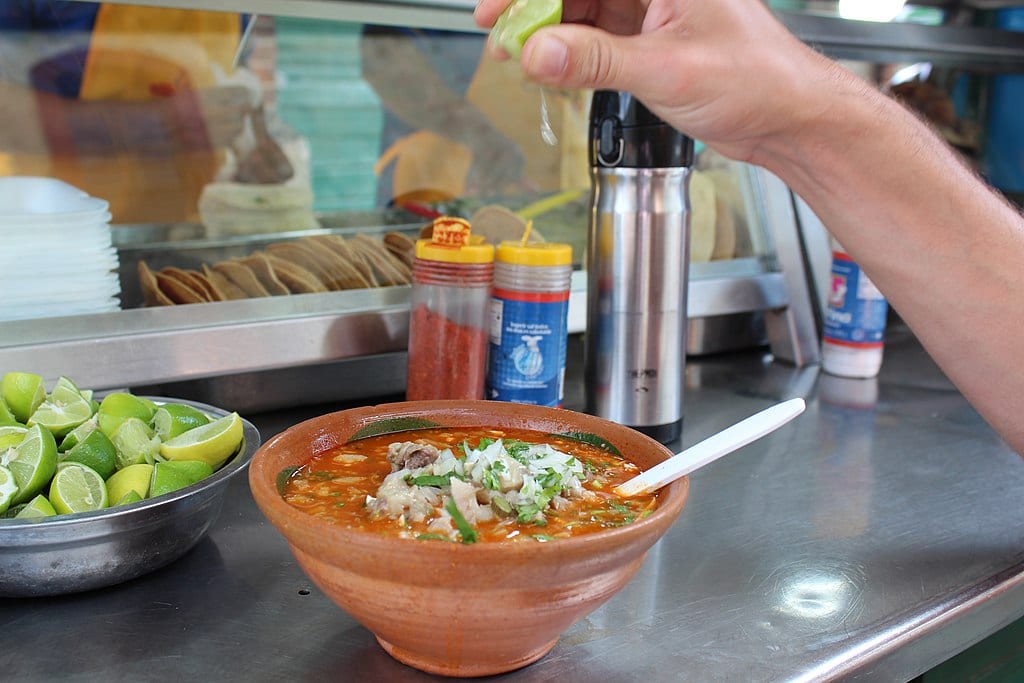
Pozole is a traditional Mexican soup that dates back to pre-Columbian times. Made with hominy (dried corn kernels that have been treated with an alkali), the soup can be prepared with either pork or chicken. The broth is flavored with garlic, onion, and various chilies, which can be red, green, or white depending on the regional variation. Once the soup is cooked, it is garnished with shredded lettuce or cabbage, radishes, lime, oregano, and chili powder. Pozole is often enjoyed during celebrations and family gatherings, providing a nourishing and flavorful meal.
🇲🇽 Variations of pozole: Depending on the region, you may encounter pozole rojo (red pozole), made with red chilies, pozole verde (green pozole), made with green tomatillos and chilies, or pozole blanco (white pozole), which is a simpler, uncolored version that lets the hominy and meat shine.
🍽️ The proper way to eat pozole: Add your garnishes of choice — lettuce, radish, lime, and a pinch of oregano — before stirring them into the soup. Take your time to enjoy each spoonful, allowing the rich broth and tender hominy to warm you from the inside out. It’s a Mexican food option that is not to be missed!
Tostadas
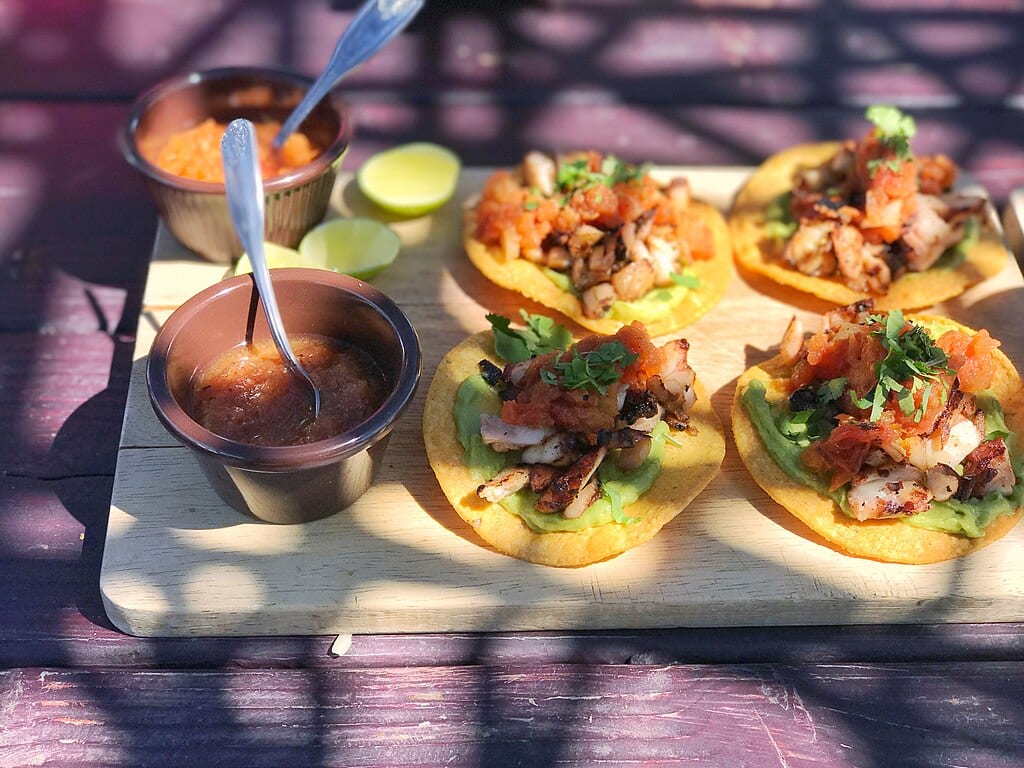
Tostadas are crispy, fried tortillas that serve as a base for a variety of toppings. They are a versatile and quintessential Mexican food dish, allowing for endless combinations of ingredients. Common toppings include refried beans, shredded chicken or beef, lettuce, cheese, salsa, and avocado. The key to a good tostada is balancing the textures and flavors, from the crunchy tortilla to the creamy beans and fresh vegetables. Tostadas are a popular lunch option because they are quick to prepare and can be customized to suit individual tastes.
🇲🇽 Variations of tostadas: Tostadas can be topped with ceviche (seafood), tinga (shredded chicken in a tomato-based sauce), or even a vegetarian mix of beans and vegetables. Some versions include sour cream or additional salsas for added flavor.
🍽️ The proper way to eat tostadas: Hold the tostada flat and bite down carefully to avoid breaking the crispy tortilla. Try to keep the toppings balanced on each bite, ensuring you get a taste of every ingredient in every mouthful. For a real Mexican touch, add a splash of salsa or a squeeze of lime.
Dinner
Dinner in Mexico is a time to wind down and enjoy the company of loved ones after a busy day. While often lighter than lunch, it’s still a meal filled with warmth and tradition. Mexicans tend to gather around the table, sharing stories and laughter as they enjoy dishes that bring comfort and satisfaction!
Mole poblano
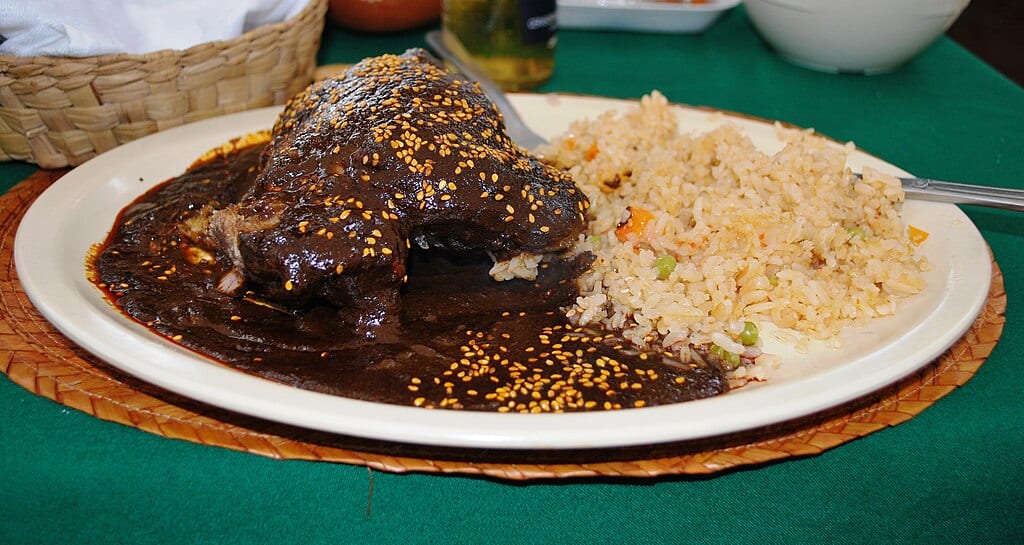
Mole poblano is one of Mexico’s most famous and complex sauces, originating from the state of Puebla. This rich, dark sauce is made from a blend of over 20 ingredients, including various chilies (such as ancho, pasilla, and mulato), chocolate, nuts, seeds, spices, and fruits. The process involves toasting and grinding the ingredients to create a thick paste, which is then simmered for hours to develop its deep, layered flavor. Mole poblano is typically served over chicken or turkey, accompanied by rice. It’s a dish often reserved for special occasions due to the labor-intensive preparation.
🇲🇽 Variations of mole poblano: Regional variations might include different types of chilies or additional spices, but the essence of the dish remains the same — a complex, flavorful sauce that is both savory and slightly sweet.
🍽️ The proper way to eat mole poblano: Start by cutting small pieces of chicken or turkey. Make sure they are well-coated with mole sauce. Eat the chicken with a forkful of rice to balance the intense flavors. Savor the deep, complex layers of spices, chocolate, and chilies in each bite!
Enchiladas
When you talk about Mexican food, enchiladas are a classic, consisting of corn tortillas rolled around a filling and covered in chili sauce. Fillings can include shredded chicken, cheese, beans, or vegetables. The key to delicious enchiladas is the sauce. This varies from red (made with tomatoes and red chilies) to green (made with tomatillos and green chilies). Once assembled, the enchiladas are baked until the cheese is melted and bubbly. They are usually garnished with onions, crema, and fresh cilantro, and served with rice and beans.
🇲🇽 Variations of enchiladas: Different regions offer variations such as enchiladas suizas (Swiss-style, with creamier sauce), enchiladas verdes (green sauce), and enchiladas rojas (red sauce). Fillings can also range from meat to potatoes or vegetables.
🍽️ The proper way to eat enchiladas: Use a fork and knife to cut through the soft tortilla. Ensure you capture both the filling and sauce in each bite. Savor the combination of flavors, from the tangy sauce to the creamy fillings. Add a bit of rice and beans to each bite for a complete and satisfying meal.
Chiles en nogada
Chiles en nogada is a traditional dish that embodies the colors of the Mexican flag: green, white, and red. Poblano chilies are stuffed with picadillo, a mixture of ground meat, fruits, nuts, and spices. The stuffed chilies are then covered in a creamy walnut sauce and garnished with pomegranate seeds and parsley. This dish is particularly popular during Mexican Independence Day celebrations in September. The combination of savory, sweet, and nutty flavors makes chiles en nogada a truly unique and festive dinner option.
🇲🇽 Variations of chiles en nogada: Some variations include different types of meat in the picadillo or additional fruits like raisins or dried apricots to enhance the sweetness.
🍽️ The proper way to eat chiles en nogada: Cut into the chili, making sure to gather a bit of the picadillo filling and nogada sauce in each bite. The balance of flavors — sweet, savory, and creamy — should be experienced together. Enjoy slowly to appreciate the complexity of this dish.
Dessert
Churros
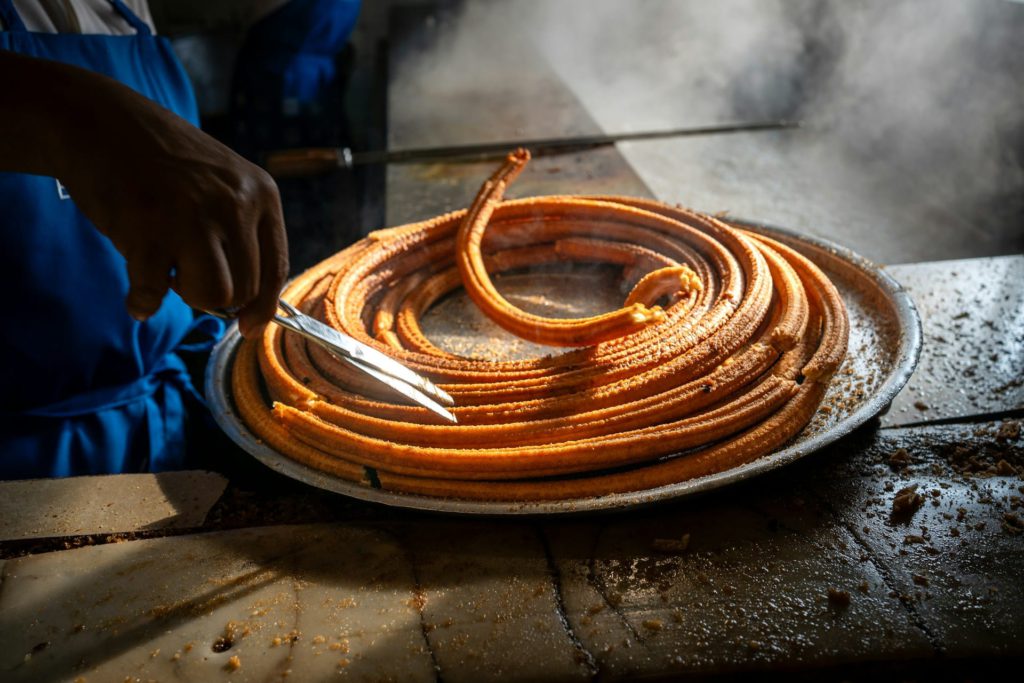
Churros are a well-loved Mexican dessert consisting of deep-fried dough pastries sprinkled with cinnamon sugar. The dough, made from flour, water, and butter, is piped through a star-shaped nozzle. This creates the churros’ signature ridges! They are then fried to golden perfection. Crispy on the outside and soft on the inside, churros are often served with a side of rich chocolate sauce or dulce de leche for dipping. An irresistible treat enjoyed at any time of day — you can’t leave out churros from any Mexican food list!
🇲🇽 Variations of churros: Churros come in various regional styles across Mexico. Churros rellenos are filled with chocolate, caramel, or cajeta. In the Sierra Norte, churros are dipped in piloncillo syrup. Churros con chocolate, served with thick chocolate sauce, are a popular variation influenced by Spanish tradition.
🍽️ The proper way to eat churros: Hold the churro by one end. Dip it generously into the chocolate or dulce de leche sauce! Take a bite, enjoying the contrast between the crispy exterior and the soft, doughy interior. Continue dipping with each bite for the ultimate sweet experience.
Flan
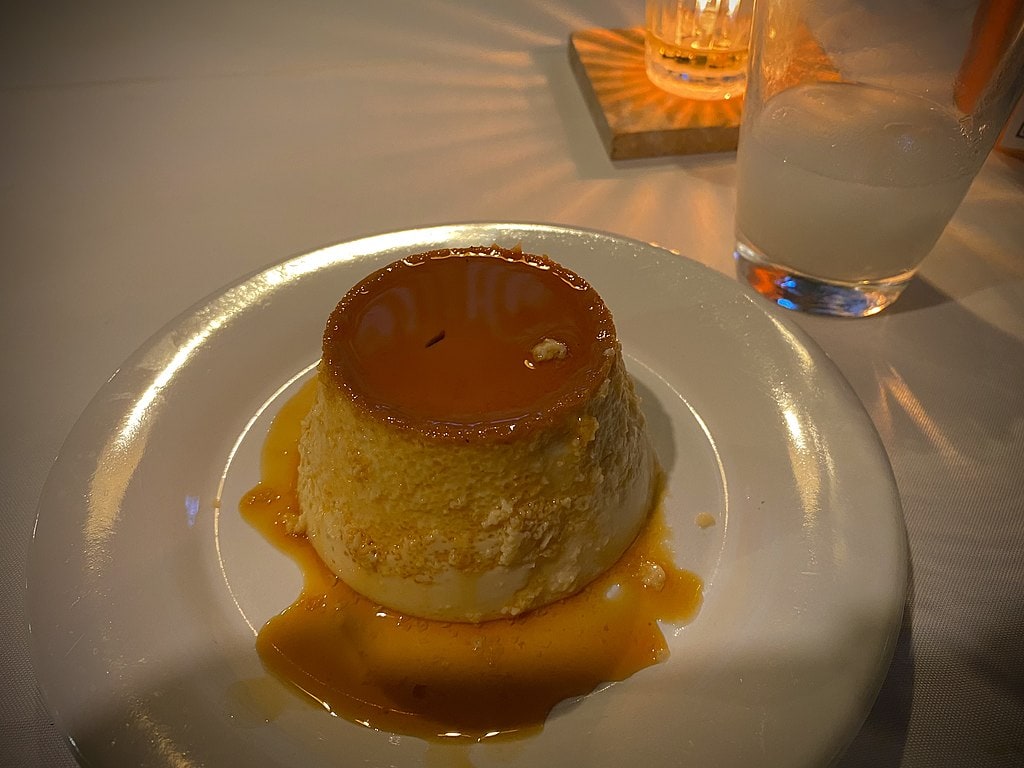
Flan is a classic Mexican dessert that features a smooth, creamy custard topped with a layer of rich caramel. Made from a simple mixture of eggs, milk, sugar, and vanilla, flan is baked in a water bath to ensure even cooking and a silky texture. Once set, the flan is inverted onto a plate, allowing the caramel to drizzle over the custard, creating a delightful contrast between the sweet, slightly bitter caramel and the rich, velvety custard.
🇲🇽 Variations of flan: Popular variations include flan napolitano, which is richer due to the addition of cream cheese; and coffee flan, where coffee is added to the custard for a deeper, more robust flavor.
🍽️ The proper way to eat flan: Use a spoon to gently scoop up the flan. Make sure to include some of the caramel sauce in each bite! Let it melt in your mouth, savoring the creamy texture and rich, sweet flavor.
Tres leches cake
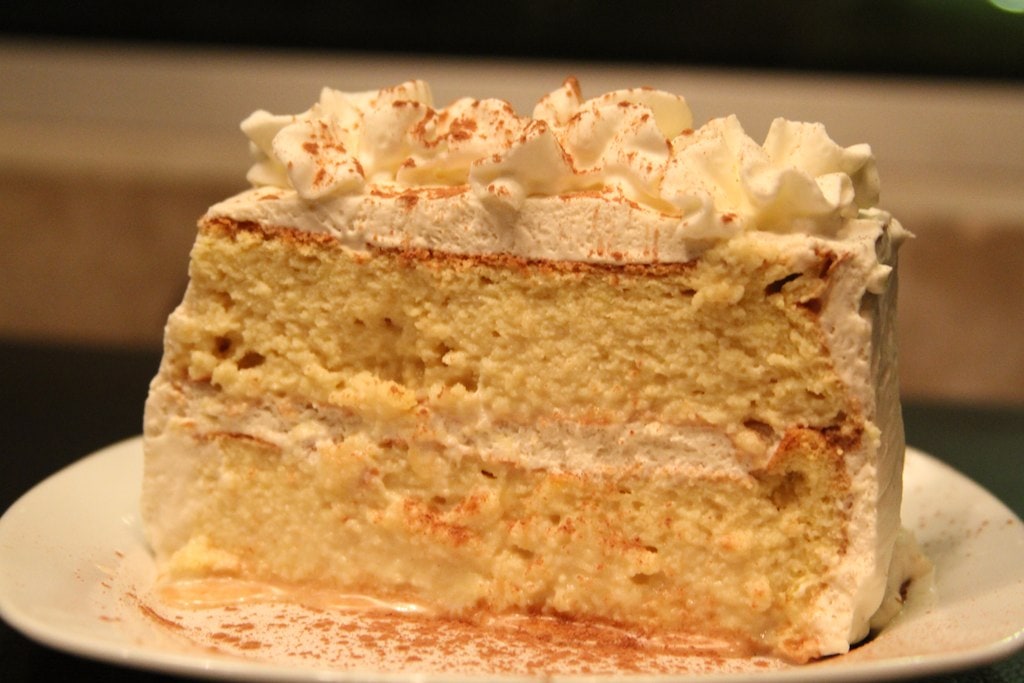
Tres leches cake is a moist, decadent dessert that gets its name from the three types of milk used to soak the sponge cake: evaporated milk, condensed milk, and heavy cream. The cake is baked, then pierced and drenched in this rich milk mixture, allowing it to absorb the flavors and achieve its unique, tender texture. Topped with whipped cream and sometimes fresh fruit, the cake is a popular choice for celebrations due to its light yet indulgent taste.
🇲🇽 Variations of tres leches cake: You may find versions that include a layer of dulce de leche for extra sweetness. Alternatively, some might add coconut milk for a unique twist. Some areas also incorporate local fruits like mango or guava into the topping for a regional flair.
🍽️ The proper way to eat tres leches cake: Use a fork to gently cut into the soft sponge cake. Ensure each bite is soaked with the three types of milk! The cake should be moist but not soggy, with a perfect balance of sweetness. Enjoy the whipped cream topping and fresh fruit garnishes, savoring the light yet indulgent flavors that make this a beloved dessert.
We hope that you’ve enjoyed this culinary adventure through Mexico and discovered some new Mexican food to treat your taste buds! Is Mexico on your travel bucket list? Check out our two-minute guide “Why travel to Mexico?” to discover the country’s best highlights!
Ready to taste these incredible dishes in their homeland? Let TourHero help you plan the best trip to Mexico. We’ll ensure you experience the authentic flavors of Mexican food and the vibrant culture of the people firsthand!
About TourHero
TourHero is a social travel platform that enables you to travel with like-minded people and fall in love with the journey. We work closely with handpicked local operators to ensure every experience curated is unique and exclusive to your travel group. Come with us on epic adventures and create memories that last a lifetime. Get started here!
